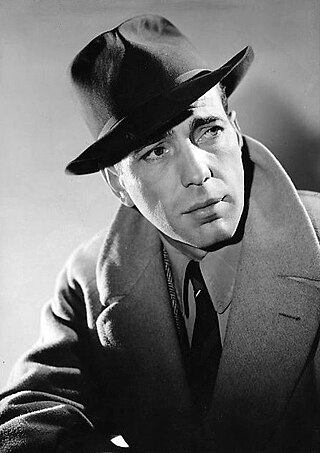
Humphrey DeForest Bogart, nicknamed Bogie, was an American actor. His performances in classic Hollywood cinema films made him an American cultural icon. In 1999, the American Film Institute selected Bogart as the greatest male star of classic American cinema.

Eldred Gregory Peck was an American actor and one of the most popular film stars from the 1940s to the 1970s. In 1999, the American Film Institute named Peck the 12th-greatest male star of Classic Hollywood Cinema.

Smash-Up, the Story of a Woman, also called A Woman Destroyed, is a 1947 American drama film with elements of film noir that tells the story of a rising nightclub singer who marries another singer and becomes an alcoholic after sacrificing her career for him.

Betty Joan Perske, professionally known as Lauren Bacall, was an American actress. She was named the 20th-greatest female star of classic Hollywood cinema by the American Film Institute. She received an Academy Honorary Award in 2009 in recognition of her contribution to the Golden Age of motion pictures. She was known for her alluring, sultry presence and her distinctive, husky voice. Bacall was one of the last surviving major stars from the Golden Age of Hollywood cinema.

How to Marry a Millionaire is a 1953 American romantic comedy film directed by Jean Negulesco and written and produced by Nunnally Johnson. The screenplay was based on the plays The Greeks Had a Word for It (1930) by Zoe Akins and Loco (1946) by Dale Eunson and Katherine Albert.

Captain Horatio Hornblower is a 1951 British naval swashbuckling war film in Technicolor from Warner Bros., produced by Gerry Mitchell, directed by Raoul Walsh, that stars Gregory Peck, Virginia Mayo, Robert Beatty and Terence Morgan.

Sabrina is a 1954 American romantic comedy-drama film directed by Billy Wilder, from a screenplay he co-wrote with Samuel A. Taylor and Ernest Lehman, based on Taylor's 1953 play Sabrina Fair. The picture stars Humphrey Bogart, Audrey Hepburn, and William Holden. This was Wilder's last film released by Paramount Pictures, ending a 12-year business relationship between him and the company.

Written on the Wind is a 1956 American Southern Gothic melodrama film directed by Douglas Sirk and starring Rock Hudson, Lauren Bacall, Robert Stack, and Dorothy Malone. It follows the complicated relationships among dysfunctional family members of a Texas oil dynasty: its alcoholic heir, his wife, his childhood best friend, and his ruthless, self-destructive sister.

Key Largo is a 1948 American film noir crime drama directed by John Huston and starring Humphrey Bogart, Edward G. Robinson and Lauren Bacall. The supporting cast features Lionel Barrymore and Claire Trevor. The film was adapted by Richard Brooks and Huston from Maxwell Anderson's 1939 play of the same name. Key Largo was the fourth and final film pairing of actors Bogart and Bacall, after To Have and Have Not (1944), The Big Sleep (1946), and Dark Passage (1947). Claire Trevor won the 1948 Best Supporting Actress Academy Award for her portrayal of alcoholic former nightclub singer Gaye Dawn.

The Big Sleep is a 1946 American film noir directed by Howard Hawks. William Faulkner, Leigh Brackett and Jules Furthman co-wrote the screenplay, which adapts Raymond Chandler's 1939 novel. The film stars Humphrey Bogart as private detective Philip Marlowe and Lauren Bacall as Vivian Rutledge in a story that begins with blackmail and leads to multiple murders.
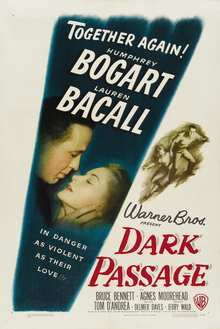
Dark Passage is a 1947 American film noir directed by Delmer Daves and starring Humphrey Bogart and Lauren Bacall. The film is based on the 1946 novel of the same title by David Goodis. It was the third of four films real-life couple Bacall and Bogart made together.
To Have and Have Not is a 1944 American romantic war adventure film directed by Howard Hawks, loosely based on Ernest Hemingway's 1937 novel of the same name. It stars Humphrey Bogart, Walter Brennan and Lauren Bacall; it also features Dolores Moran, Hoagy Carmichael, Sheldon Leonard, Dan Seymour, and Marcel Dalio. The plot, centered on the romance between a freelancing fisherman in Martinique and a beautiful American drifter, is complicated by the growing French resistance in Vichy France.

The Big Clock is a 1948 American thriller directed by John Farrow and adapted by novelist-screenwriter Jonathan Latimer from the 1946 novel of the same title by Kenneth Fearing.
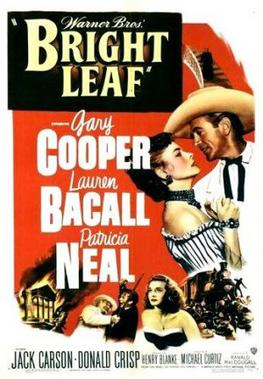
Bright Leaf is a 1950 American Drama Western film directed by Michael Curtiz and starring Gary Cooper, Lauren Bacall and Patricia Neal. It is adapted from the 1949 novel of the same name by Foster Fitz-Simons. The title comes from the type of tobacco grown in North Carolina after the American Civil War. According to Bright Leaves, a 2003 documentary film by Ross McElwee, the plot is loosely based on the rivalry of tobacco tycoons Washington Duke and John Harvey McElwee, the filmmaker's great-grandfather.

They Drive by Night is a 1940 American film noir directed by Raoul Walsh and starring George Raft, Ann Sheridan, Ida Lupino, and Humphrey Bogart, and featuring Gale Page, Alan Hale, Roscoe Karns, John Litel and George Tobias. The picture involves a pair of embattled truck drivers and was released in the UK under the title The Road to Frisco. The film was based on A. I. Bezzerides' 1938 novel Long Haul, which was later reprinted under the title They Drive by Night to capitalize on the success of the film.

The Mirror Has Two Faces is a 1996 American romantic comedy-drama film produced and directed by Barbra Streisand, who also stars. The screenplay by Richard LaGravenese is loosely based on the 1958 French film Le Miroir à deux faces written by André Cayatte and Gérard Oury. Also starring are Jeff Bridges, Pierce Brosnan, George Segal, Mimi Rogers, Brenda Vaccaro, and Lauren Bacall. The story focuses on a shy, middle-aged professor (Bridges) who enters into a platonic relationship with an unlucky-in-love colleague (Streisand).
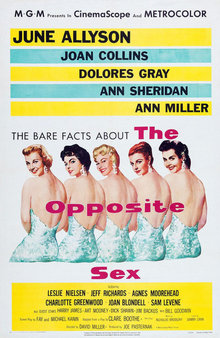
The Opposite Sex is a 1956 American musical romantic comedy film shot in Metrocolor and CinemaScope. The film was directed by David Miller and stars June Allyson, Joan Collins, Dolores Gray, Ann Sheridan, and Ann Miller, with Leslie Nielsen, Jeff Richards, Agnes Moorehead, Charlotte Greenwood, Joan Blondell, and Sam Levene.

Blood Alley is a 1955 American seafaring Cold War adventure film produced by John Wayne, directed by William A. Wellman, and starring Wayne and Lauren Bacall. The film was distributed by Warner Bros. and shot in CinemaScope and Warnercolor. The film depicts a voyage from Chiku Shan, a village on the Communist Chinese coast, all the way to Hong Kong via the Formosa Strait.
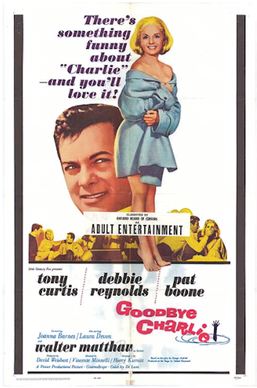
Goodbye Charlie is a 1964 American comedy film directed by Vincente Minnelli and starring Tony Curtis, Debbie Reynolds and Pat Boone. The CinemaScope film is about a callous womanizer who gets his just reward after a jealous husband kills him. It is adapted from George Axelrod's 1959 play Goodbye, Charlie. The play also provided the basis for the 1991 film Switch, with Ellen Barkin and Jimmy Smits.

American actress Lauren Bacall (1924–2014) had an extensive career in films, television shows, and plays. She was one of the leading ladies during the Golden Age of Hollywood along with actresses such as Marilyn Monroe and Rita Hayworth. Bacall started her career as a teenage fashion model when she appeared on the cover of Harper's Bazaar and was discovered by Howard Hawks' wife Nancy. As she naturally had a high-pitched and nasal voice, she received lessons to help deepen it and was required to shout verses by Shakespeare for hours every day as part of her training.


















